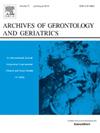中老年人糖尿病与虚弱的双向关系:系统回顾和荟萃分析
IF 3.8
3区 医学
Q2 GERIATRICS & GERONTOLOGY
引用次数: 0
摘要
背景:糖尿病和虚弱在中老年人群中普遍存在,且负担沉重。然而,目前关于两者关联的证据并不一致,也没有定量的荟萃分析。我们进行了一项系统回顾和荟萃分析,以检查糖尿病是否会增加虚弱的风险,反之亦然。方法系统检索PubMed、Web of Science、Embase和CINAHL数据库,检索时间为建库至2025年4月10日。横断面分析采用随机效应模型计算合并优势比(OR)和95%置信区间(CI),纵向分析采用合并相对危险度(RR)。使用建议评估、发展和评价分级(GRADE)框架评估证据的确定性。结果在8559份非重复记录中,共纳入31篇文献。糖尿病患者普遍虚弱的风险增加(OR=2.21, 95% CI: 1.60-3.06, I2= 99.0%, n = 15;GRADE=Low),普遍的前期虚弱(OR=2.23, 95% CI: 2.19-2.28, I2= 0.0%, n =2;GRADE=非常低)和事件虚弱(RR=1.50, 95% CI: 1.36-1.65, I2= 0.0%, n = 7;级=中等)。前虚弱组(OR=1.95, 95% CI: 1.61 ~ 2.36, I2= 0.0%;GRADE=非常低)但不伴有虚弱(OR=2.28, 95% CI: 0.96-5.46, I2= 92.3%;在两项研究中,GRADE=非常低)增加了流行糖尿病的几率。在15项研究中,糖尿病发生率的合并rr为1.47 (95% CI: 1.37-1.57, I2= 91.0%;GRADE=中度)和1.96 (95% CI: 1.73-2.23, I2= 92.7%;GRADE=中度)。结论:我们的研究结果支持糖尿病与中老年人群虚弱之间的双向关系,每一种情况都促进了另一种情况的发展。这突出了糖尿病和虚弱的早期发现和综合管理战略的重要性。本文章由计算机程序翻译,如有差异,请以英文原文为准。
Bidirectional relationship between diabetes and frailty in middle-aged and older adults: A systematic review and meta-analysis
Background
Diabetes and frailty are prevalent and burdensome in middle-aged and older adults. However, current evidence on their association is inconsistent, and no quantitative meta-analysis exists. We conducted a systematic review and meta-analysis to examine whether diabetes increased the risk of frailty and vice versa.
Methods
We systematically searched PubMed, Web of Science, Embase, and CINAHL databases from inception to 10 April 2025. Random-effects models were used to calculate pooled odds ratio (OR) and 95 % confidence interval (CI) for cross-sectional analysis and pooled relative risk (RR) for longitudinal analysis. The certainty of evidence was evaluated using the Grading of Recommendations Assessment, Development and Evaluation (GRADE) framework.
Results
From 8559 non-duplicated records, 31 articles were included. People with diabetes had increased risks of prevalent frailty (OR=2.21, 95 %CI: 1.60–3.06, I2=99.0 %, n = 15; GRADE=Low), prevalent pre-frailty (OR=2.23, 95 %CI: 2.19–2.28, I2=0.0 %, n = 2; GRADE=Very low), and incident frailty (RR=1.50, 95 %CI: 1.36–1.65, I2=0.0 %, n = 7; GRADE=Moderate). Those with pre-frailty (OR=1.95, 95 %CI: 1.61–2.36, I2=0.0 %; GRADE=Very low) but not with frailty (OR=2.28, 95 %CI:0.96–5.46, I2=92.3 %; GRADE=Very low) had increased odds of prevalent diabetes in two studies. In 15 studies, the pooled RRs for incident diabetes were 1.47 (95 %CI: 1.37–1.57, I2=91.0 %; GRADE=Moderate) in pre-frail participants and 1.96 (95 %CI: 1.73–2.23, I2=92.7 %; GRADE=Moderate) in frail participants.
Conclusion
Our findings support the bidirectional relationship between diabetes and frailty in middle-aged and older adults, with each condition contributing to the development of the other. This highlights the importance of early detection and integrated management strategies for diabetes and frailty.
求助全文
通过发布文献求助,成功后即可免费获取论文全文。
去求助
来源期刊
CiteScore
7.30
自引率
5.00%
发文量
198
审稿时长
16 days
期刊介绍:
Archives of Gerontology and Geriatrics provides a medium for the publication of papers from the fields of experimental gerontology and clinical and social geriatrics. The principal aim of the journal is to facilitate the exchange of information between specialists in these three fields of gerontological research. Experimental papers dealing with the basic mechanisms of aging at molecular, cellular, tissue or organ levels will be published.
Clinical papers will be accepted if they provide sufficiently new information or are of fundamental importance for the knowledge of human aging. Purely descriptive clinical papers will be accepted only if the results permit further interpretation. Papers dealing with anti-aging pharmacological preparations in humans are welcome. Papers on the social aspects of geriatrics will be accepted if they are of general interest regarding the epidemiology of aging and the efficiency and working methods of the social organizations for the health care of the elderly.

 求助内容:
求助内容: 应助结果提醒方式:
应助结果提醒方式:


